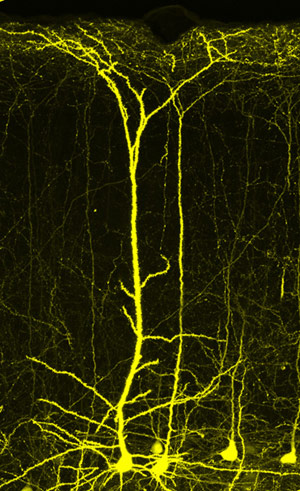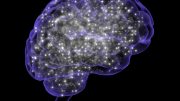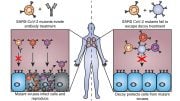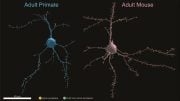
Researchers in Stanford’s Bio-X program are investigating growth in the neurons involved in a mouse’s visual system. Credit: Maja Djurisic
New research from Stanford Bio-X scientists shows that the brains of adult mice are able to form new synapses by disabling the function of a single protein for as little as a week. This research has the potential to help adults recover from stroke and forms of blindness or to prevent the loss of connections in Alzheimer’s disease.
At critical times in the brain’s development, windows open when neurons can reach out and form new connections. The language window, for example, is open in time for kids to learn multiple languages and speak them like a native. Then it mostly closes, leaving adults fumbling for words and unable to roll their ‘R’s.
The question has been what controls that window, and, more to the point, what can be done to prop it open later in life. Knowing that could do more than simply help older people with a travel bug. It could allow the brain to recover from stroke, some forms of blindness, Alzheimer’s disease, and other conditions that result from the loss of connections in the brain and an inability to form many new ones.
Now a team of scientists at Stanford University has found that disabling the function of a single protein for as little as a week allows the brains of adult mice to form new connections, called synapses.
“To me, this is amazing because what this is saying is that it is possible to induce new synapses in adult brains,” said Carla Shatz, the David Starr Jordan Director of Stanford Bio-X, which supports interdisciplinary biomedical research. Shatz was senior author on a research paper describing this work, published October 15 in Science Translational Medicine.
Propping open the window
In previous work, Shatz and her team had found a protein called PirB that seemed to control when the synapse formation window is open or shut. That protein sits on the surface of neurons and immune cells in mice and, in the absence of other signals, does nothing. In this situation, the neuron is able to form new connections.
But during times when the window should be shut – which is to say most of adulthood – other proteins latch onto PirB. Under those conditions, PirB sends a signal into the neuron, telling it to stop making new connections and even remove some that aren’t necessary. It is essentially an on/off switch for synapse formation, where proteins binding to PirB turn off synapse formation and turn on the pruning of existing connections.
In previous work, adult mice that were made to lack PirB had the brain’s window for forming new synapses propped open throughout life. The mice recovered more quickly from stroke and could create connections in their visual systems even as adults.
That work was exciting but left a number of open questions in terms of whether it could help people. The mice were genetically engineered to lack PirB – something that isn’t possible in people. Also, those mice lacked PirB throughout their brain development. It wasn’t clear whether a drug that temporarily eliminated PirB in adult brains would restore the ability to form new synapses later in life.
Decoy protein
David Bochner, a graduate student in Shatz’s lab and the first author on the paper, tricked this delicate system by flooding the brain with a specially engineered form of PirB that acted like a decoy. All the various proteins that would normally bind PirB and cause it to shut down new synapse formation instead were tricked to latch onto this decoy PirB. That left the PirB on the neuron’s surface vacant and silent, switching synapse formation into the on position.
The team tested this drug in a form of blindness that results from the inability to create new connections in the adult visual system. Adult mice that had been given this decoy drug were able to form connections and recover at least some vision.
Shatz and her team first covered an eye in mice until after the window closed on forming new connections between the eye and the visual system. Then they uncovered the eye and found that, as expected, the eye that had been covered could not form new connections with the visual system and the mice could not see.
They then delivered the decoy PirB into the brain’s visual centers, and the treated mice regained the ability to make new connections, partially restoring vision from the previously closed eye. The team also counted how many physical connections existed in the visual system and found significantly more in the mice that had received the decoy PirB.
This model that the team studied in mice directly applies to forms of blindness in people. Children who are born with cataracts need to have the problem repaired while the vision processing region of the brain is still able to form new connections with the eyes. “If the damage isn’t repaired early enough, then it’s extremely difficult if not impossible to recover vision,” Shatz said.
If a version of the decoy protein could work in people, then kids born with cataracts in countries with limited access to surgery could potentially have their cataracts removed later, receive a drug, and be able to see. Similarly, the window could be briefly opened to help people recover from a stroke or other conditions.
“Wouldn’t it be great if while you were in rehabilitation after stroke you could open the plasticity just briefly, then close it again to allow recovery of speech?” Shatz asked.
Path to humans
All of this raises the question of why we don’t all take daily doses of any pill Shatz might be able to develop and keep the learning window open permanently. “At first I thought, ‘I want to take this pill right away,’ but maybe we want to think about that,” Shatz said.
“During these early critical periods you want to learn rapidly,” said Shatz, who is also the Sapp Family Provostial Professor and professor of biology and of neurobiology at Stanford University School of Medicine. “When this is happening, the connections are changing so fast that they are very unstable. This is part of why kids are susceptible to epilepsy. After the critical period, you want to stabilize and avoid the risk of deleting connections that you really need.”
There are still barriers to creating such a pill for use in people. First, researchers need to understand better the human version of PirB, which differs from the mouse version in several ways. Also, the group had to inject PirB directly into the mouse brain because this type of drug doesn’t cross what’s known as the blood/brain barrier that prevents potential toxins in the blood from reaching the brain. A way of getting any drug through that barrier and into the brain would need to be found.
“The good news is that the adult brain houses some of the molecules and mechanisms needed to create robust new connections, but normally these mechanisms are mostly turned off,” Shatz said. “The decoy PirB shows that they are accessible under the right circumstances.”
Reference: “Blocking PirB up-regulates spines and functional synapses to unlock visual cortical plasticity and facilitate recovery from amblyopia” by David N. Bochner, Richard W. Sapp, Jaimie D. Adelson, Siyu Zhang, Hanmi Lee, Maja Djurisic, Josh Syken, Yang Dan and Carla J. Shatz, 15 October 2014, Science Translational Medicine.
DOI: 10.1126/scitranslmed.3010157









Be the first to comment on "Decoy Drug Allows Brains of Adult Mice to Form New Synapses"